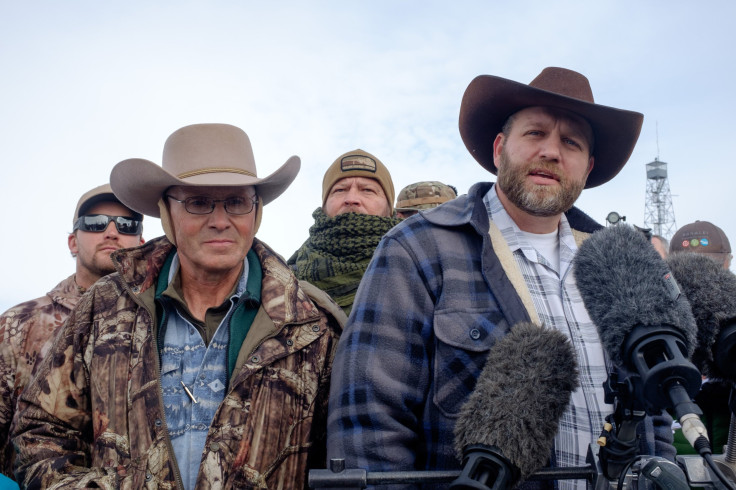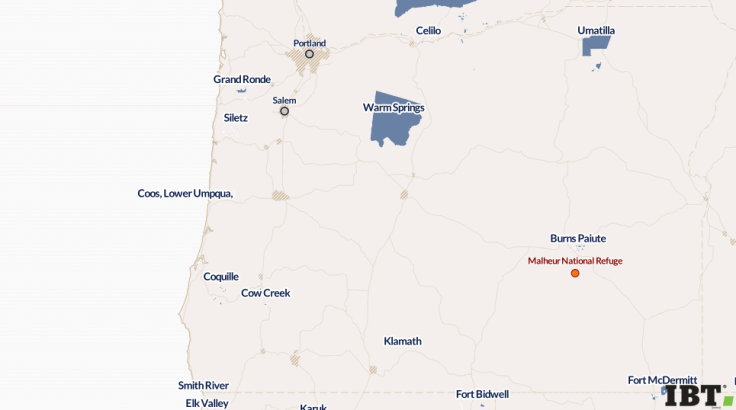Native Americans React To Oregon Armed Occupation: Burns Paiute Tribe Says, ‘We Were Here First’

As armed ranchers continued to occupy federal land in eastern Oregon for a fifth consecutive day, the leader of the area’s Native American tribal council spoke out in anger and frustration. “We were here first,” Charlotte Rodrique, chairwoman of the federal recognized Burns Paiute Tribe, said at a press conference Wednesday.
The protesters want the government to relinquish the federal land to local ranchers, loggers and miners. But the area in question, the Malheur National Wildlife Refuge, is actually native Paiute land that was ceded to white settlers over a hundred years ago. And while the native people can relate to the protesters’ dispute, they don’t appreciate their guns and they want to make clear whose land it really is.
“Armed protesters don’t belong here,” Rodrique said at the press conference in the sleepy town of Burns, saying they were “desecrating one of our sacred sites.”
Armed anti-government protesters took over the headquarters building at the federal wildlife preserve Saturday, accusing federal officials of unfairly punishing ranchers who refused to sell their property. The gun-toting protesters, led by Ammon Bundy, are also demonstrating in support of two local ranchers who were charged with arson after starting a prescribed fire on their private property that spread onto public land. The group said they have no intentions of vacating the premises, despite requests from the Burns Paiute Tribe leaders.

For hundreds of years, the Northern Paiute inhabited much of eastern Oregon and northern Nevada, but the land was eaten up by European-American settlers. In 1872, U.S. President Ulysses S. Grant set aside a small part of their former territory and established the Malheur Reservation for the Northern Paiute, which included the area of the Malheur National Wildlife Refuge. But the federal government closed the reservation after the Bannock War of 1878 and opened it up for settlers.
Today, the native people continue to inhabit what’s left of the Malheur Reservation, the small Burns Paiute Reservation, and the Malheur Wildlife Refuge is now a federal game preserve. The Paiute, along with thousands of other Native Americans across the United States, have been fighting to reclaim their native land for years but are taking a less provocative approach.
Jarvis Kennedy, a member of the Burns Paiute tribal council, slammed federal law enforcement for appearing content to monitor the situation, saying their reaction might be different if armed Native Americans took over the wildlife refuge. “What if it was a bunch of natives who went in there and took it?” Kennedy said at the press conference Wednesday. “They just need to get the hell out of here ... We don’t want them here.”

Beth Piatote, an associate professor of Native American studies at University of California, Berkeley, said the armed protesters have no moral claim to the land and the Paiute should be part of the discussion. Piatote, who is Nez Perce and an enrolled member of the Confederated Tribes of the Colville Reservation in nearby Washington, said the dispute in Oregon is a part of a greater story about native experience.
“They talk about their motives, about wanting to continue to live as they have, to provide for their families. These are the very same claims native people made a hundred years ago as they were being forcibly removed from their homelands or being confined to much smaller land,” she said in a telephone interview Wednesday. “This land is disputed land and it’s Paiute land and native people should be at the table in this conversation.”
Mark Trahant, the Charles R. Johnson Endowed Professor of Journalism at the University of North Dakota and former president of the Native American Journalists Association, said the native people in the Northwest generally have good relations with ranchers. Still, he hoped the ongoing occupation will spark a greater discussion about native land rights and perhaps allow the Paiute to return to their former territory.
“The connection to the land is really deep," said Trahant, an enrolled member of Idaho’s Shoshone-Bannock Tribes. "It’s not just a piece of ground for ranching. It has much more significance.”
© Copyright IBTimes 2024. All rights reserved.






















